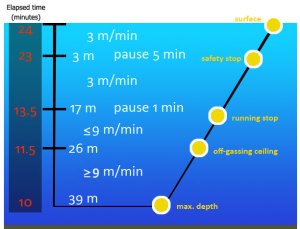kaylee_ann
crazy diver
I'm going to get crap for this. so much crap. why I decided to even post it, not totally sure, but nobody else would probably know but this forum. I've tried looking it up online and can't find really anything.
to preface this, it's only for brain exercise and academic purposes. I am NOT going to actually put this into practice. I just love to learn and know the mechanics behind decompression theory. always have, probably always will, BUT it does not mean I am doing it in real life. it's just for fun! I'd never actually do a decompression dive based on this.
oh eta- I'm not gonna teach anyone this either
so for academic purposes, how do you calculate where your first decompression stop is based on depth and time? I think you have to factor in estimated tissue loading, which the formulas are somewhere in Deco For Divers which I have. but I'm not sure how, once you get the number for that, to find your first stop. again, I'm absolutely NOT going to put this into practice! I just love to learn. it's nothing more than that, I swear.
anyway, is it even possible to calculate this? or am I dreaming up something that you can't really do? I'm sure there's a way since dive computers do it constantly. lots and lots of math though, I'd presume.
thanks to anyone who answers the question nicely
to preface this, it's only for brain exercise and academic purposes. I am NOT going to actually put this into practice. I just love to learn and know the mechanics behind decompression theory. always have, probably always will, BUT it does not mean I am doing it in real life. it's just for fun! I'd never actually do a decompression dive based on this.
oh eta- I'm not gonna teach anyone this either
so for academic purposes, how do you calculate where your first decompression stop is based on depth and time? I think you have to factor in estimated tissue loading, which the formulas are somewhere in Deco For Divers which I have. but I'm not sure how, once you get the number for that, to find your first stop. again, I'm absolutely NOT going to put this into practice! I just love to learn. it's nothing more than that, I swear.
anyway, is it even possible to calculate this? or am I dreaming up something that you can't really do? I'm sure there's a way since dive computers do it constantly. lots and lots of math though, I'd presume.
thanks to anyone who answers the question nicely







